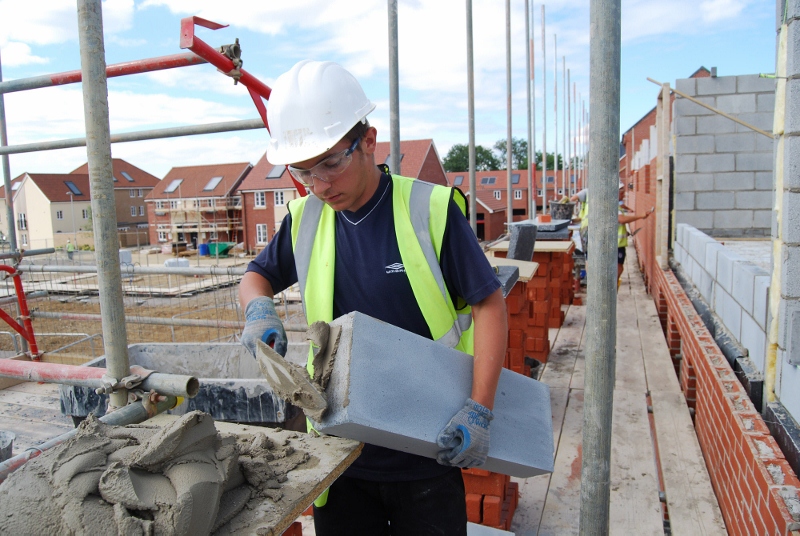The next government could add £51.2bn to the economy, including £12bn profit to the taxpayer, by building 90,000 social homes, according to new research carried out by CEBR on behalf of Shelter and the National Housing Federation (NHF).
The new report, The economic impact of building social housing, is the first to show the massive economic and social benefits of building 90,000 new social rented homes – the figure that needs to be built each year to fix the housing crisis and help end homelessness.
Social rented housing is the only genuinely affordable housing by design, as rents are tied to local incomes. On average, social rents are around 50% cheaper than private rents.
The report demonstrates that building 90,000 social homes provides both immediate and long-term value for money for the government and the economy. It would directly support nearly 140,000 jobs in the first year alone. Within three years, the wider economic benefits of building the homes would break even and return an impressive £37.8bn back to the economy, largely by boosting the construction industry.

Alongside this, the new social homes would generate huge savings for the taxpayer across multiple departments. These breakdown as follows:
- £4.5bn savings on housing benefit
- £2.5bn income from construction taxes
- £3.8bn income from employment taxes
- £5.2bn savings to the NHS
- £4.5bn savings from reduction in homelessness
- £3.3bn savings to Universal Credit
The savings and additional tax revenue mean the initial government funding required to build the homes (£11.8bn) would be fully paid back in 11 years. Over the 30 year period, building these homes will add £12bn net (£24bn gross) in benefits to the taxpayer.
Social homes are more stable than private renting, as tenancies are secure, giving social tenants stronger rights and greater protection from eviction. As a result, the socioeconomic benefits of building 90,000 social homes, outlined in this new research report are significant, and include better education outcomes, savings to the NHS, increasing rates of employment and reduced crime. The total economic and social benefits of building the homes would generate £51.2bn net over 30 years (£86.5bn gross).
For decades, successive governments have failed to build enough social homes and every year we lose more than we build through right-to-buy sales and demolitions. Last year alone, there was a net loss of nearly 11,700 social homes, while 1.3 million households are stuck on social housing waiting lists in England. One in six children are living in an overcrowded home and a record 140,000 children are homeless and living in damaging temporary accommodation, such as one-room hostels and B&Bs, often miles away from their schools. Thousands more people are forced to sleep on the street.
Ahead of the general election, Shelter and the NHF are calling for political parties to commit to end the housing crisis. This can only be done with a long-term plan which prioritises social housing, including urgent action to ramp up delivery of 90,000 new social homes a year to meet demand.
Polly Neate, Chief Executive of Shelter, said: “Homelessness is a political choice, with a simple solution. Building 90,000 social homes a year will not only end the housing emergency, but due to the wider economic benefits it brings, it will pay for itself within just three years.
“Day after day our frontline services are inundated with calls from people who are being tipped into homelessness because there are no genuinely affordable homes available and private renting is just too expensive. Communities are being torn apart as people are priced out of their local areas - leaving behind their jobs, children’s schools and support networks.
“It doesn’t have to be this way. A safe and secure social home will give people a place to thrive – improving their health and access to work and education. All political parties must make the choice to ending the housing emergency - they must fully commit to building 90,000 new genuinely affordable social rent homes a year for ten years.”
Kate Henderson, Chief Executive of the National Housing Federation said: “This research shows not only that the housing crisis can be solved, but that this can be done in a way that will save the taxpayer money, boost jobs and bring huge benefits to the wider economy.
“Right now, we are in the midst of a housing emergency. Millions of children are being pushed into homelessness, families are being forced into impossible choices to keep a roof over their heads and people in every community in the country are seeing life chances harmed by inadequate housing.
“Building more social homes is a win-win solution. It will immediately boost the construction industry, supporting thousands of jobs, and will save the government and taxpayer money over the longer term. It also brings huge benefits to people affected by the housing crisis through reducing homelessness, increasing employment and boosting children’s life chances. We urge all political parties commit to a long-term plan for housing with funding to build plan for a generation of new social homes.”
Benefits bill and homelessness budget – £4.5bn
The dire shortage of social homes has led to significant increases in spending on housing benefit. The benefit bill has doubled since the early 2000s, as low-income families have been trapped in privately rented homes where rents are at a record high. Meanwhile, spending on temporary accommodation has increased by a staggering 62% over the last five years.
However, this new research shows building 90,000 social homes would save councils £245m/year on homelessness services – 10% of total spending last year – and result in £4.5 bn in savings over the next 30 years. It would also save nearly £250m/year on the benefits budget, and result in £4.5bn in housing benefit savings over the long term.
Health and savings to the NHS - £5.2bn
Decades of failure to build good quality social homes has trapped people in insecure private renting where poor conditions are rife. According to the government’s own data, social housing has the lowest proportion of non-decent homes, damp and health hazards of any other housing tenures, including owner-occupied and private rented homes. A stable home is also linked to better wellbeing. This research shows that building 90,000 new social homes could save the NHS £5.2 billion and would lead to a substantial reduction in annual health services usage of £1,914 per household.
Children’s life chances and education – £2.7bn
Recent research by Shelter has exposed the devastating impact poor housing has on school age children, causing huge disruption to their education. Half of teachers (49%) report working with children who are homeless or who have become homeless in the last year. A shocking 91% of teachers say children are coming to school tired as a result, while 86% say it’s caused children to miss school.
In the longer term, poor housing leads to lower economic contributions, increased crime, and greater use of public services. Building 90,000 new social homes would reduce disruptions to education and lead to overall savings of £2.7 billion.
Higher employment – £8.9bn
A stable, affordable home helps people to get and keep work, and can reduce the long-term scarring effect that being homeless or in insecure housing has on people’s employment prospects. These benefits generate £8.9bn for the wider economy, in addition to £3.8bn generated through increased tax revenue.
Lower benefit costs – £3.3bn
Due to higher employment, yearly benefit claims would be cut by £1,218 per household, generating £3.3bn in savings over the long term.
Reduced crime – £3.1bn
People in inadequate housing are more likely to experience crime. This means that more social homes means that fewer people would suffer the health and financial costs of crime, and lead to savings to the police and criminal justice systems. Combined, this would generate savings of £3.1bn.




















